AUD/USD is starting the week on shaky ground, trading at its lowest levels in over five weeks in the mid-0.66s. This week’s economic calendar is relatively light on both local and international fronts. However, the focus is shifting towards significant events scheduled for late October and early November. These include the release of the Q3 CPI data on 30th October, US October payrolls report on 1st November, and most importantly, the US presidential election and the Reserve Bank of Australia (RBA) meeting on 5th November.
Following a robust September jobs report last week, where employment surged by 64.1k, the Australian dollar briefly found some stability. With five consecutive months of stronger-than-expected job numbers, totaling over 200k, the unemployment rate remained steady at 4.1%. Consequently, the local interest rate markets revised their expectations for a rate cut by the RBA. The forecast for the February 2025 meeting was adjusted to -20bp from -25bp, and expectations for three 25bp rate cuts in 2025 emerged.
Despite briefly reclaiming the 0.6700 level towards the end of the previous week, the AUD/USD pair faced headwinds at the start of the new week. As the US presidential election approaches, with polls favoring Trump in swing states, markets are now pricing in the potential for increased fiscal stimulus and trade tariffs under a Republican-led government.
The recent rise in long-term US yields, reaching 3-month highs at 4.19%, reflects improved US economic data and reduced expectations for further Fed rate cuts. Fed officials have signaled a more measured approach to future rate adjustments. The possibility of a “Red sweep” in the upcoming US election, where Republicans secure majorities in both houses of Congress, could lead to the implementation of Trump’s policy proposals, including tax cuts and tariffs.
In contrast, China’s policy initiatives aim to bolster economic growth through debt swaps and property market support. Plans for a large debt swap program and increased funding for the property sector indicate a proactive approach to addressing financial challenges. Despite these efforts, concerns remain about the oversupply in lower-tier cities and its impact on the banking sector.
Looking ahead, the focus in the coming weeks will be on key economic events such as the Q3 CPI release, US payrolls report, and the US election. Market participants will closely monitor these developments for potential implications on currency movements and global economic conditions. Additional insights from international meetings and speeches by central bank officials will also provide valuable guidance for investors navigating the evolving economic landscape.

















